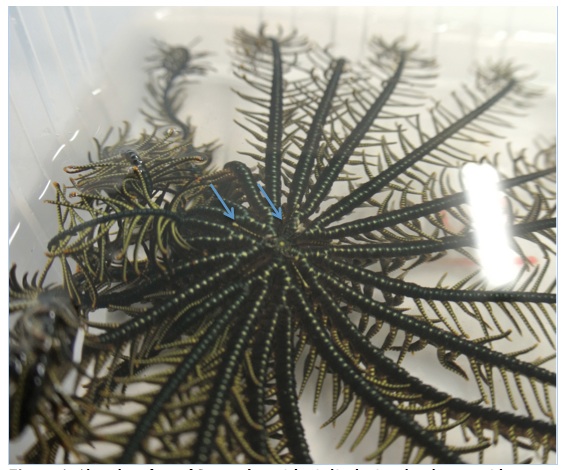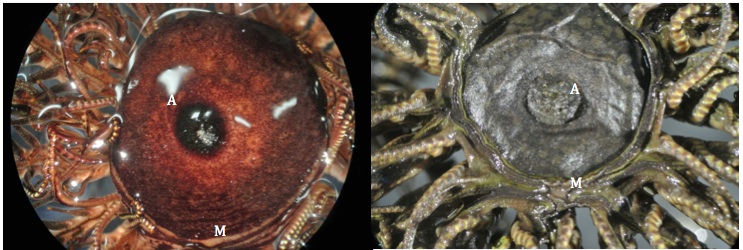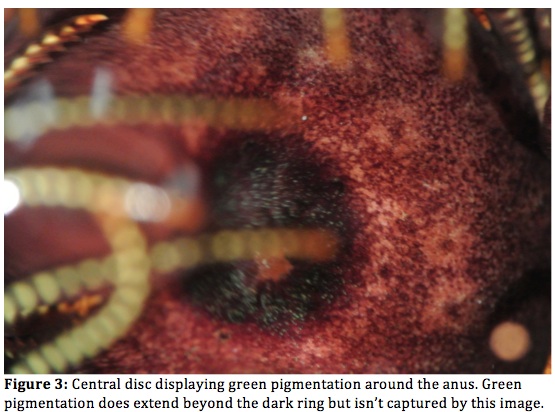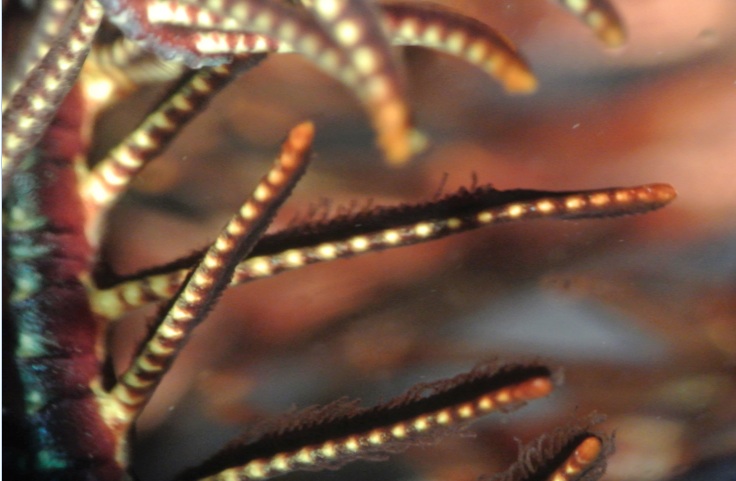Physical Description

Comanthus gisleni is a stalk-less green crinoid that has distinctive patterning that blends it into the downward facing coral rubble on Heron Island. The stalk that normally supports the central-body (disc) is absent in this species, instead it has a clasper made up of slender cirri. Cirri are result of the adaptation of the last remaining segment of the stalk – the centro-dorsal plate. The average length of the cirri on this Comanthus species was 0.8cm (fig. 1).

Figure 1: Aboral surface of Comanthus gisleni, displaying the clasper with multiple cirri (arrows).
The central disc on average was 1cm in diameter. The colouration of the central disc was a maroon under direct light and green from a distant (Fig. 2). When specimens were treated with ethanol the organism lost all maroon colouration (Fig. 2). The green colouration was made by green pigments in the tissue (Fig. 3).

Figure 2: Central Disc of Comanthus gisleni before and after ethanol treatment. Ethanol treatment was applied to transportation the specimens to the University of Queensland. In the dead specimen on the right the food groove (ambulacra groove) can be seen leading to the non-central mouth (M). The anus (A) or excretion zone located centrally on the body.

The crown of Comanthus gisleni consists of approximately 20-25 arms that deviate from ~10 radiates. A radiate is a branch from the central body that splits into two or more arms. A long each arm are secondary appendages called pinnules. The pinnules give the crinoid its “feathery” appearance.
The pinnules of this species had distinct collouration.The pinnules tip are yellow and are slightly modified into small hooks - they act like "velcro" when touched (Hoggett, N/A). The oral surface has yellow to cream colouration a long the arms, yellow-green speckled pattern on the pinnules, deep green in the feeding groove (ambulacra) and a dark maroon central disc. The aboral surface is dark green-black with yellow-green perpendicular strips (fig. 1 & fig. 4). The green pigmentation can be seen through out all the tissue along the arms (fig. 4).
 
Figure 4: The pinnules of several arms of Comanthus gisleni with the varying colours and patterns it displays.
One ambulacral groove radiates and diverges from the mouth across the central disc onto the rays and their branches (Fig. 2). Each consists of a ciliated food groove lined with finger like, food-collecting podia (or tube feet; extensions of the water vascular system) (Fig. 5).
 
Figure 5: Tube feet extended out of the pinnules into the water column collecting food to filter down the ambulacra (food groove) to the mouth on the side of the central disc.
Note:
For important keys to identifying crinoids please refer to Charles Messing website (address located in references and resources). Further information about the tegmen please refer to Anatomy and Physiology. |